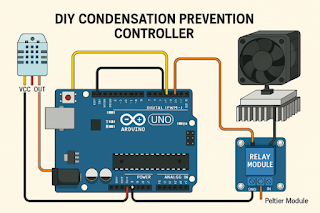DIY Smart Peltier Controller for Condensation Prevention Using Arduino
One of the biggest concerns when cooling electronic equipment is condensation. Especially when using a Peltier module for cooling, improper design can lead to condensation that damages electronic circuits. In this post, we introduce how to build a DIY smart Peltier controller using Arduino to prevent condensation. The step-by-step explanation is easy to follow, even for beginners.
The Peltier module cools one side while heating the other, making it popular in mini coolers, beverage chillers, and optical equipment. However, if the cooled surface temperature falls below the dew point, condensation occurs as moisture in the air turns into water droplets. This condensation can cause serious problems for electronic equipment, so building a smart controller to prevent it is essential.
DIY Smart Peltier Controller Design Overview
The DIY smart controller for condensation prevention consists of the following components:
- Temperature and humidity sensor (DHT22 or SHT31): Measures ambient conditions around the equipment
- Arduino UNO: Reads sensor data and calculates the dew point
- Relay module: Controls power to the Peltier module
- Peltier module (TEC1-12706): Performs cooling and heating
- Cooling fan + heatsink: Dissipates heat from the hot side of the Peltier
The Arduino calculates the dew point based on temperature and humidity data, and turns the Peltier module on or off to keep the cooling plate’s target temperature at least 2-3°C above the dew point.
Example Arduino Control Logic
Below is a simple code structure for the Peltier controller:
#include <DHT.h>
#define DHTPIN 2
#define DHTTYPE DHT22
DHT dht(DHTPIN, DHTTYPE);
int relayPin = 4;
void setup() {
Serial.begin(9600);
dht.begin();
pinMode(relayPin, OUTPUT);
}
void loop() {
float t = dht.readTemperature();
float h = dht.readHumidity();
float dewPoint = t - ((100 - h) / 5.0);
if (t < dewPoint + 2) {
digitalWrite(relayPin, LOW); // Peltier OFF (prevent condensation)
} else {
digitalWrite(relayPin, HIGH); // Peltier ON
}
delay(2000);
}
This code calculates the dew point from the temperature and humidity, and activates the Peltier module only when the target temperature is safely above the dew point to minimize condensation risk.
DIY Tips
- Place the sensor and Peltier in the same space to reflect actual ambient conditions.
- Consider upgrading to a MOSFET circuit for more precise control instead of a relay.
- Use the Serial Monitor to check real-time data during testing.
- Add a drip tray and drainage design around the cooling plate to safely handle any condensation.
The Arduino IDE makes library installation and code uploading easy, and even beginners can implement this by following various tutorials.
Conclusion
An Arduino-based smart Peltier controller for condensation prevention is a simple yet powerful solution. Even without a complex system, combining understanding of air conditions with smart control makes it useful for small and industrial devices. Start building your safe, condensation-free cooling system today!
The Arduino condensation prevention controller is the best DIY project for protecting electronics while improving energy efficiency.
This blog explains in detail how to build a smart Peltier controller for condensation prevention using Arduino in over 3000 characters.
Arduino, condensationprevention, peltiercontrol, smartcooling, DIYelectronics, tempsensor, dewpointcontrol, electronicsprotection, relaymodule, coolingdesign
